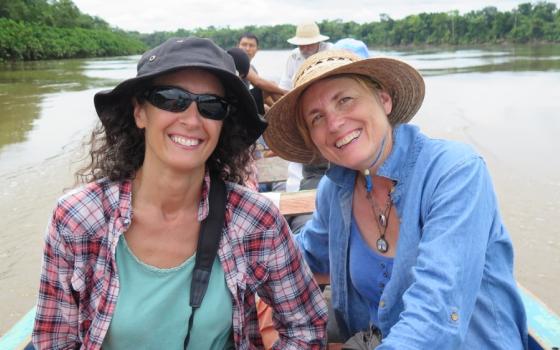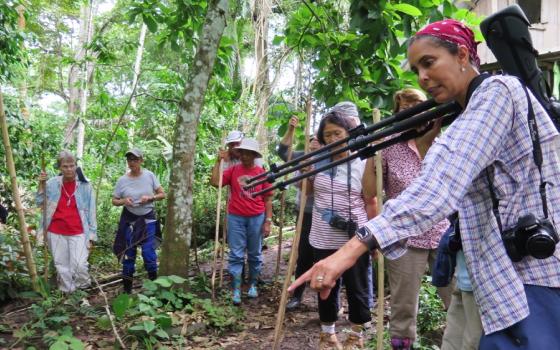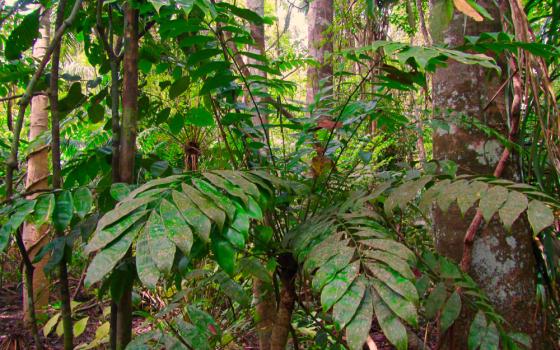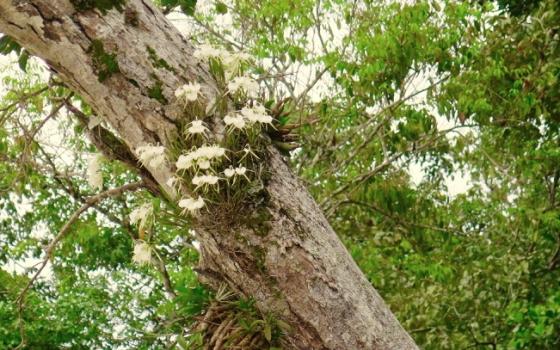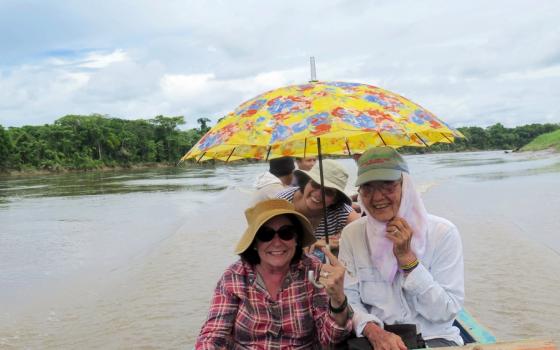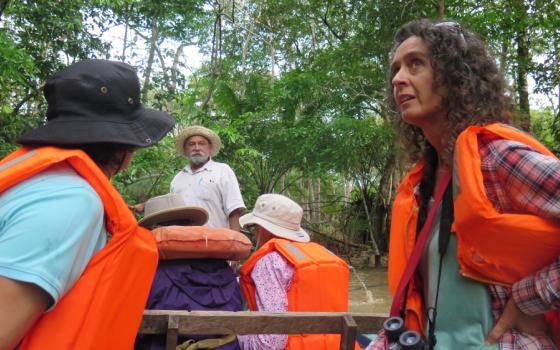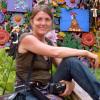Estas son las olas de la mar (These are the waves of the ocean)
Estas son las olas que van y viene (These are the waves that come and go)
Estas son las olas del Río Tuira (These are the waves of the River Tuira)
Estas son las olas de mi Darién. (These are the waves of my Darién.)
- Darién Bunde y Bullarenge
Now that I'm back home in Mexico, Panama lingers in my memory like the sharp taste of Café Durán on the back of my tongue. Swaying to the lively beat of Bunde y Bullarenge, a collection of the traditional music of the Afro-Darienitas, I think of the people who made this music and the person who gifted us with it: Hermel López, one of the speakers at the June 22-July 1 Web of Life retreat organized by the Maryknoll Sisters of Panama.
For 10 days in the tropical rainforests of Darién and the urban landscape of Panama City, scientists and academics converged with theologians, sisters, writers and spiritual seekers to explore the places where ecology, spirituality and science intersect in the context of the web of life.
An indomitable spirit himself, López represents the best of the Afro-Panamanian culture and of his native Darién. He told us of the cimarrones, the escaped slaves who made their way down into the jungle where the hacienda owners feared to follow and made a life there among the boa constrictors and the jaguars in the lands of the native Kuna. He told us of the importance of the vast network of wetlands and rivers and lagoons that make up Matusagaratí, place of legends and lore for Darienitas since time immemorial.
The endangered wetlands in Darién, under attack by foreign agribusinesses that burn and deforest it, kill its animals and drain its abundant life, represent the intricacies of the natural systems that support the planet, as we learned from our presenters. Its barely understood hydrological systems support the interconnection of waters from the sea to the land and back again.
I saw this with my own eyes as I watched the crystal-clear waters of a spring mingle with tidewaters and pour into the murky River Tuira below, one of several that feed the wetlands system. I saw a crocodile lurking in the shadows, a warning that we were entering territory that demands respect. And I felt it in the current of the tides that pulled us forward, at times with a force capable of capsizing us and teaching us a lesson about our place in the web of life — because it is indeed a web, not a pyramid in which perceiving our place at the top is a seriously misguided illusion.
López's position as regional director of the Ministry of the Environment seems to have become a casualty of that illusion, as he was sent on involuntary "vacation" after filing a series of lawsuits aimed at protecting the endangered wetlands. This followed the resignation of former Minister of the Environment Mirei Endara, who supported López's legal initiatives, and the exile of journalist Ligia Arreaga, Matusagaratí's greatest defender, who fled the country after repeated death threats.
There in the forests and wetlands of Darién, we thrilled to the joy of life surging at its fullest, most fecund expression high among the treetops in the roar of the howler monkey and the nesting egrets, cranes and herons and below us in the march of the carpenter ants and the flow of the mighty Tuira. We lived those interconnections every day as we ate the fruits of the forest and the farm, as we harvested the sun to charge our devices, as we bathed in captured rainwater. The land entered us, became us, and we became, in a small way, one with the land. There in the rainforest, at the Maryknolls' pastoral center, it was easy to feel that this connection with creation is one and the same as a connection with the divine.
At the same time, we heard about the struggle for the continued survival of the species that share these lands, including the jaguar, which in the race to clear more forest for industrial agriculture is being killed off much faster than it can reproduce. America's largest feline, the very essence of wildness, could be extinct in Panama in 25 years if current trends are not reversed, we were told.
And the jaguar is only the most visible manifestation of what scientists are calling the sixth mass extinction. With dozens of species vanishing every day, never to return, how are we to reconcile this? We must confront the dark shadow of our culture, that dominant ethic that places profit above life, and we must find ways to shift that tide.
______
Each time you look at a tangerine, you can see deeply into it. You can see everything in the universe in one tangerine. When you peel it and smell it, it's wonderful. You can take your time eating a tangerine and be very happy.
- Thich Nhat Hanh, Peace Is Every Step: The Path of Mindfulness in Everyday Life
Each day, the Web of Life began at 7 a.m. with a different reflection. Usually, I'd been rushing since 5 a.m. to file a story, select photos, write captions and arrive on time to calm my harried mind and capture the moment. On this day, it was the gentle and measured voice of Maryknoll Sr. Melinda Roper that brought me back to Earth, sharing a meditation from one of my favorite teachers, the beloved Thich Nhat Hanh.
I listened to her reading of the story and then took a tangerine as the bowl was passed around. She invited us to close our eyes, and she led us on a journey from below the moist, dark earth, where a seed sprouted and, ever so slowly, grew into a tree, sprouted fruit, and produced the tangerine that lay in my hand. And within each fruit, she reminded us, there are more seeds.
"Through this tangerine that we are now going to taste, we are in communion with the Earth, with the rain, with the sun, with the wind — we are in communion with the people who have harvested and shared this fruit so that it could be in our hand today," Roper said. "I invite you to taste and experience this communion with the whole universe sharing this tangerine — in silence, with much reverence, with much respect, tenderness and love, conscious of what we are tasting."
I closed my eyes and took my first bite, a tiny explosion of liquid flavor. I listened to the rain drumming on the roof — the same rain that was falling on a tangerine tree somewhere, on Matusagaratí, on the jaguar, on the harpy eagle, perhaps on a migrant in some part of this continent, trying to find his way across the border into a more hopeful future.
I thought of the gentle Thich Nhat Hanh, now a renowned author and teacher, himself a refugee once, helping boat people flee for their lives on the open seas in those terrible years of the war in his native Vietnam. Even on pain of death, he continued to be an outspoken advocate for peace and justice. And he continued to practice loving kindness, to hold the light and the shadow of the present moment together in his enormous heart, and to enjoy the flavor and the meaning of a single tangerine.
______
Moments and memories I will never forget: waking before 5 a.m. as the sisters begin their day, hearing their soft voices in the candlelight, setting to work as Roper brings me a welcome cup of coffee. Learning that the sisters like to go to bed at 9 p.m. so they can wake up early — but that they like to have a beer and conversation before. And learning that joining them in this could be a help, more than a hindrance, to my writing process.
Watching Maryknoll Sr. Jocelyn Fenix, a medical doctor turned holistic healer who is reintegrating into the mission after four years away, as she tends to wounds and ills with tenderness and competence, then becomes a mischievous and playful sprite.
Laughing at all hours with my wise, funny and enormously capable roommate Clara Meza, a successful businesswoman from Panama City who, inspired by the sisters, has moved to Darién to work with the people.
"We are all in the midst of our own conversion — an ecological conversion," she said in her closing reflections. "And as we leave here, it's up to us to share that." Spoken as a new kind of missionary.
______
My introduction to the school of thought known as evolutionary spirituality through the rituals and prayers and readings of Maryknoll Sr. Peg Dillon was a powerful gift. I was raised a fundamentalist Christian, so evolution was first presented to me as the deceptive work of the devil, an evil or at least misguided scheme to lead people astray from the word of God.
While I soon came to see things differently, I never fully explored that apparent schism between science and religion. The Web of Life opened a window into a whole world, far from new but new to me. I began to see the many ways in which evolutionary science has not only been embraced and celebrated by people of faith, but also held up as divine revelation, inspiration and evidence of an even vaster God than traditional religions portray.
Dillon pointed me in the direction of Pierre Teilhard de Chardin, a French Jesuit priest, paleontologist and philosopher and one of the pioneers of this perspective. Back home, I began to explore his work and was pleased to find Franciscan Sr. Ilia Delio's thought-provoking column published last week in Global Sisters Report: "What would Teilhard say? Evolve or be annihilated." Its thesis was perhaps one of the unspoken messages of the Web of Life. The piece cites another writer cited during the retreat, a much more familiar name to me: eco-theologian Passionist Fr. Thomas Berry.
His words brought me back to our current dilemma. I close with his call to action, never more urgent than now:
"We will go into the future as a single sacred community, or we will all perish in the desert."
Evolution in this context is not a mere concept; it's a mandate, an urgent necessity. May we learn to embrace it together; may we find our way back to our proper place in harmony amid the web of life before it's too late.
[Tracy L. Barnett is an independent writer, editor and photographer specializing in environmental issues, indigenous rights and sustainable travel.]
